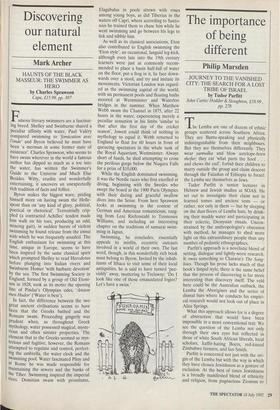The importance of being different
Philip Marsden
JOURNEY TO THE VANISHED CITY: THE SEARCH FOR A LOST TRIBE OF ISRAEL by Tudor Parfitt John Curtis! Hodder & Stoughton, £18.99, pp. 278 he Lemba are one of dozens of ethnic groups scattered across Southern Africa. They are Bantu-speaking and physically indistinguishable from their neighbours. But they see themselves differently. They wear yarmulka and blow antelope-horn shofar; they eat 'what parts the hoof . . . and chews the cud', forbid their children to marry outside the group and claim descent through the Falashas of Ethiopia to Israel: the Lemba see themselves as Jews.
Tudor Parfitt is senior lecturer in Hebrew and Jewish studies at SOAS. He set out to investigate their claim not in learned tomes and ancient texts — or rather, not only in them — but by sleeping on the dust-floors of Lemba huts, by drink- ing their muddy water and participating in their eclectic, Dionysian rituals. Uncon- strained by the anthropologist's obsession with method, he manages to shed more light on this extraordinary people than any number of pedantic ethnographies.
Parfitt's approach is a novelistic blend of setting, dialogue and lightly-worn research. It owes something to Chatwin's The Song- lines. Though his prose lacks much of that book's limpid style, there is the same belief that the process of discovering is far more interesting than discovery itself. The veld here could be the Australian outback, the Lemba the Aborigines and the series of dismal bars where he conducts his empiri- cal research would not look out of place in Alice Springs.
What this approach allows for is a degree of abstraction that would have been impossible in a more conventional text. We see the question of the Lemba not only through their own eyes but reflected in those of white South African liberals, local scholars, kaffir-hating Boers, red-kneed Zimbabwe farmers, and Ian Smith.
Parfitt is concerned not just with the ori- gin of the Lemba but with the way in which they have chosen Jewishness as a gesture of exclusion. At the best of times Jewishness is a broadly manifested blend of ethnicity and religion, from pugnacious Zionism to mystical prayer. Here it is paraded simply to say, 'We are Lemba, we are different'.
Why they established this tradition is unclear. The most plausible explanation is that they were a group of native traders and smiths who were exposed to some sort of Semitic influence from the coast, includ- ing, perhaps, intermarriage. Through this they achieved prominence, and wanted to preserve it. Endogamy and weird rites ensured that.
So the Lemba are not a lost tribe of Israel. They are not the remnant of some ancient African diaspora, and did not troop thousands of miles through the Dark Continent clinging the while to their Judaic traditions.
In fact Parfitt finds many things to sug- gest the Lemba are as much Islamic as Judaic. At one assembly, one of the elders confesses the two most revered Lemba invocations: Bismillahi (in the name of Allah) when you butcher a chicken, and Allahu akbar (Allah is great) when you initiate the boys. This second is what today's Palestinians tend to cry just before they murder Israelis. If ever the Lemba reached the Promised Land and cried that during circumcision their Jewishness would be in severe doubt.
The specific claim of Jewish origin would appear to be a fairly new thing. Perhaps, Parfitt suggests, it was sharpened by the pressures of colonialism, even bolstered in recent years by publicity surrounding the Falashas. If the Lemba may not thank Parfitt for debunking their romantic myth of descent, at least they can be sure they won't be whisked off to Israel to suffer the ignominies of the Falashas' resettlement.
Parfitt examines in some detail the Lemba role in Great Zimbabwe, the only mediaeval city in central and southern Africa. The question of who built it has long been one of the fields where the racial battles of Southern Africa are fought. Most recently it has been strewn with mines by the partisans of the politically correct.
Colonialists argued that it was Phoeni- cians who were behind the site. They found, among other things, evidence of Lebanese cedar in the lintels. They say its ruined state bears out the inherent hope- lessness of the natives. Now post-colonial trends have swung the pendulum towards similarly dubious extremes. 'Afro-centric' is the buzz-word, in which everything is African-built and even classical civilisation has an exclusively African provenance.
Parfitt steps into the Great Zimbabwe minefield with a further revision — that the Lemba played a major role in the building and development of the city. When he sug- gests this to one of the site directors, the man tries to storm out of their meeting. `No! No! No!', he cries, taking `Lemba' to mean 'Jew' and 'Jew' to mean 'non- African'. The man attacks Parfitt's thesis as the worst form of white-farmer bigotry.
'Sit down', growls Parfitt, and goes on to explain that the Lemba are not outsiders. Their Jewishness is adopted; they are black, after all. Parfitt is forgiven and Great Zimbabwe remains an indigenous monument.
It is in this area that TudOr Parfitt's book is most successful. He has a keen eye for the absurd, and there is no shortage of that both in Southern Africa and in current scholarship. Implicit in his conclusions is the danger of determinism in dealing with cultural diffusion. To assume that influ- ences spread from one people to the next in a linear fashion is akin to ascribing some sort of Darwinian progression to history. Parfitt shows that our immediate reaction on discovering, for example, black Jews in Southern Africa is bound to be wrong, and heavy with our own ideological baggage.



















































 Previous page
Previous page